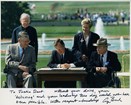Disability History: An Overview brings attention to some of the many disability stories interwoven across the National Park Service’s 400+ units and its programs. “Disability stories” refer to the array of experiences by, from, and about people with disabilities represented across our nation. People with disabilities are the largest minority in the United States, but their stories often remain untold.
-
Article 1: Disability History Series Introduction

The Telling All Americans’ Stories Disability History series brings attention to some of the many disability stories interwoven across the National Park Service’s 400+ units and its programs. “Disability stories” refer to the array of experiences by, from, and about people with disabilities represented across our nation. People with disabilities are the largest minority in the United States, but their stories often remain untold. Read more
-
Article 2: Disability History: Early and Shifting Attitudes of Treatment

Before Dorothea Dix and other healthcare reformers advocated for better treatment in hospitals and almshouses, what were the experiences of people with disabilities like in the 1700s and 1800s? How can studying this history help us understand the everyday lives of people with disabilities, their perceptions of themselves and society’s perceptions of them? Read more
-
Article 3: Disability History: Educational Reform

Education for people with disabilities developed in an era shaped by the Civil War, abolition, and scientific discoveries. These events impacted education and the reformers who pushed for it. The reform of education for people with disabilities in the 1800s was a reaction to the absence of educational opportunities for these populations. Read more
-
Article 4: Disability History: The Disability Rights Movement

Treatment and perceptions of disability have undergone transformation since the 1900s. This has happened largely because people with disabilities have demanded and created those changes. Like other civil rights movements, the disability rights movement has a long history. Examples of activism can be found among various disability groups dating back to the 1800s. Many events, laws, and people have shaped this development. Read more
-
Article 5: Disability History: Military and Disability

The United States has a long history of caring for its service men and women. Since the Civil War era, the Federal Government has provided doctors to support its veterans’ physical and emotional well-being. Battlefields and military hospitals help tell this story. All sites related to war and military action have disability history, since war inevitably means some soldiers will come home with short-term or long-lasting disabilities. Read more
-
Article 6: Disability History: Presidents and Disability

Nearly 50 million people live with disabilities in the US. This population has included our nation's presidents. Dwight Eisenhower had a learning disability. Abraham Lincoln lived with depression. James Madison had epilepsy. Franklin D. Roosevelt had polio. John F. Kennedy lived with several medical issues. Places associated with these presidents, including those in NPS parks and recognized by NPS programs, continue to honor these presidents' memories. Read more
-
Article 7: Disability History: The NPS and Accessibility

The National Park Service strives to make its parks, monuments, and historic sites available to all. Programs, services, and products, such as Braille alternatives of print material, sign language interpretation of tours, accessible camping sites and trails, ramps and elevators make parks more accessible. These are essential to allowing the public to fully enjoy NPS resources. Read more
Last updated: May 19, 2025
